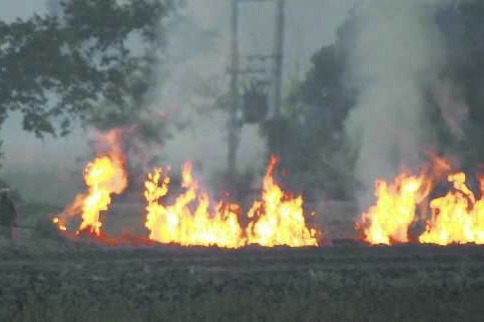
Maybe I over reacted, I do have a tendency to hit the panic button sooner than later. But there is no denying that the sight made my eyes sting and throat tighten. I have vivid memories of the sickening post Diwali gloom that engulfed us last year. Hence my ‘over’ reaction when I stepped out on the terrace for my ‘morning brew with a view’ and found it strewn with black burnt straw. It was a tell tale sign that stubble had been burnt in the neighbourhood, a foretelling of the apocalyptic horizon of grey that awaits us this winter.
Every year around this time, farmers from Punjab and Haryana burn crop waste as a low cost straw disposal practice. The pollution hence caused is further aggravated by a drop in wind velocity. The dust from construction sites, vehicle emissions and the fireworks of the festive season further push up levels of the tiny suspended particulate matter PM 2.5 and PM 10 above safe limits. We North Indians are thus condemned to breathe unbreathable air.
The downside of stubble burning is obvious, the smoke produces a cloud of particulates that is visible from space. Apart from the pollution and loss of nutrients which could otherwise enrich the soil, there is a risk of the fire getting out of hand and spreading further than intended. The government has made great efforts to create awareness regarding this. Laws against stubble burning are being implemented more strictly. Using both carrot and stick options, the government is offering subsidies on farm equipment and imposing fines on defaulters. Yet grassroots workers proclaim that neither the fear of penalties nor the lure of subsidies will curb this problem.
While it is easy to dismiss the farmers as uncaring and irresponsible, if we delve deeper we will see the obvious. It is not possible that the polluting smoke which bothers us doesn’t bother them when they set their fields ablaze. Despite this and the risk of social ostracisation and penalties farmers are resisting the ban.
My patients enlightened me on the reasons behind this. Apart from small benefits like killing herbicide resistant weeds and pests, the main advantage of this practice is that it reduces the turnaround time between harvesting paddy and sowing wheat. Vis-à-vis mechanical tilling it is a quick and cheap method to clear the fields and get them ready in the fortnight available to do this. Any delay entails losses. Despite the subsidy, the cost of machines needed to shred and spread the stubble is still prohibitive. Renting the equipment is not a viable option as there are very few available per village. Another problem is while wheat stubble is gainfully used as cattle fodder, paddy crop residue has limited use. In such a scenario paying the fine of 2500/- imposed by the Haryana government seems to be the best option.
Nothing much will happen till farmers are adequately compensated and better alternatives like using stubble as biomass are offered. No politician will take on the powerful farmer lobby, much less a beat constable. The result is that stubble burns unabated. Data from remote sensing centres shows a 72% decrease in incidence of stubble burning in Punjab and 40% decrease in Haryana. While this is very encouraging, the celebration maybe premature as paddy harvesting was delayed due to incessant rains.
There is a long way to go before stubble burning is completely eliminated, but with some care we could breathe easy this winter. Let’s stop cribbing and complaining and do our bit by saying an emphatic and resounding no to crackers. It may not be enough, but is a good place to start!
( published in my column in the Tribune on 27/10/2018)